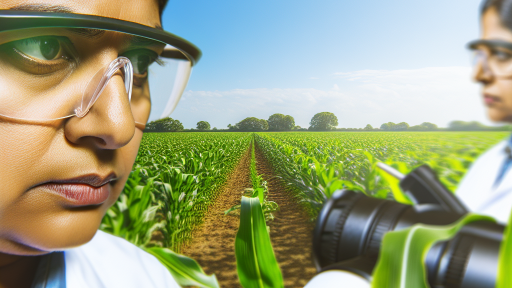Introduction to Genetically Modified Agriculture and Its Purpose
Genetically modified agriculture (GMA) involves the alteration of plant DNA.
This technique aims to improve crop yield and resistance to pests.
Farmers utilize GMA to enhance food security and sustainability.
Moreover, genetically modified crops can reduce the need for chemical pesticides.
This approach may lead to less environmental contamination overall.
In addition, GMA can help crops withstand adverse weather conditions.
For instance, certain varieties can tolerate drought or flooding.
Consequently, farmers experience more stable production levels.
The technology also has the potential to improve nutritional content.
Developers aim to create crops fortified with essential vitamins and minerals.
Despite its benefits, GMA remains a topic of public debate.
Some people express concerns about its environmental impact.
Conversely, proponents argue that GMA is necessary for modern agriculture.
Understanding both perspectives is crucial for informed discussions.
Overview of the Environmental Impact of Traditional Agriculture
Soil Degradation
Traditional agriculture often leads to soil degradation.
Transform Your Agribusiness
Unlock your farm's potential with expert advice tailored to your needs. Get actionable steps that drive real results.
Get StartedThe overuse of chemical fertilizers depletes soil nutrients.
This practice reduces the soil’s ability to retain water.
Consequently, erosion increases, damaging the land further.
Water Usage
Water consumption in traditional agriculture is substantial.
Irrigation practices can waste large quantities of water.
This situation strains local water resources and ecosystems.
Furthermore, groundwater depletion has serious long-term consequences.
Pesticides and Herbicides
Farmers frequently use pesticides and herbicides.
These chemicals can contaminate nearby water sources.
Moreover, they pose risks to wildlife and human health.
Integrated pest management can reduce these negative effects.
Loss of Biodiversity
Traditional agricultural practices often contribute to biodiversity loss.
Monoculture planting diminishes ecosystem variety.
This approach makes crops more vulnerable to pests and diseases.
Increasing crop diversity can help enhance ecological stability.
Greenhouse Gas Emissions
Traditional agriculture emits significant greenhouse gases.
Livestock farming contributes notably to methane emissions.
Additionally, nitrogen-based fertilizers release nitrous oxide.
Adopting sustainable practices can mitigate these emissions.
Benefits of Genetically Modified (GM) Crops on Ecosystem Sustainability
Enhancing Crop Yields
Genetically modified crops significantly increase agricultural productivity.
This boost helps meet the rising global food demand.
Higher yields reduce the necessity for expanding farmland.
Consequently, this practice helps preserve natural ecosystems.
Pest and Disease Resistance
GM crops often possess built-in resistance to pests and diseases.
Showcase Your Farming Business
Publish your professional farming services profile on our blog for a one-time fee of $200 and reach a dedicated audience of farmers and agribusiness owners.
Publish Your ProfileThis trait minimizes the need for chemical pesticides.
As a result, it leads to fewer harmful substances in the environment.
Moreover, this reduces the disturbance to beneficial insects.
Reduced Resource Use
Many genetically modified crops are engineered for drought resistance.
This attribute enables farmers to utilize less water.
As climate change progresses, this feature proves useful.
Additionally, reduced water usage supports local ecosystems.
Soil Health Improvement
GM crops can promote healthier soils through reduced tillage.
Minimal tillage enhances soil structure and prevents erosion.
Also, it helps maintain moisture levels in the soil.
These practices contribute to long-term agricultural sustainability.
Biodiversity Conservation
Genetically modified crops can help conserve biodiversity.
By requiring fewer chemicals, they foster healthier ecosystems.
Moreover, they can contribute to the preservation of native species.
Thus, they promote a more balanced ecological landscape.
Economic Advantages for Farmers
GM crops often lower production costs for farmers.
With fewer resources needed, farmers can achieve higher profits.
This financial benefit encourages sustainable farming practices.
In turn, these practices can enhance local economies.
Delve into the Subject: Streamlining Farm Operations With Automated Machinery
Potential Risks of GM Crops on Biodiversity and Ecosystem Health
Impact on Non-Target Species
GM crops can affect non-target species in their ecosystems.
For instance, pesticide-resistant crops may alter populations of beneficial insects.
This change can lead to reductions in natural pest control.
Consequently, the balance of the local ecosystem may be disrupted.
Gene Flow and Genetic Diversity
Gene flow from GM crops to wild relatives creates hybrid plants.
These hybrids can outcompete native plants for resources.
As a result, genetic diversity within wild populations decreases.
This loss of diversity affects ecosystem resilience and adaptability.
Soil Health Concerns
GM agriculture may impact soil health negatively.
For example, continuous use of herbicide-resistant crops may lead to soil compaction.
Furthermore, it encourages the growth of certain weed species over others.
Such changes can harm beneficial soil organisms crucial for nutrient cycling.
Effects on Pollinators
The introduction of GM crops could disrupt pollinator populations.
For example, the use of Bt crops may impact butterfly and bee species.
These pollinators are essential for the reproduction of many plants.
If their populations decline, biodiversity may be significantly affected.
Long-Term Ecological Consequences
Over time, reliance on GM crops may create new ecological challenges.
For instance, monoculture practices can lead to habitat destruction.
This destruction affects numerous species reliant on diverse habitats.
A future dominated by fewer crop varieties threatens overall ecosystem health.
Showcase Your Farming Business
Publish your professional farming services profile on our blog for a one-time fee of $200 and reach a dedicated audience of farmers and agribusiness owners.
Publish Your ProfileSee Related Content: Smart Irrigation and Precision Agriculture Benefits
Impact of GM Crops on Soil Health and Microbial Diversity
Effects on Soil Nutrient Composition
Genetically modified (GM) crops can alter soil nutrient availability.
This alteration occurs due to changes in root structures.
Changes in root exudates influence microbial activity.
Consequently, soil nutrient cycling may become more efficient.
However, some studies indicate reduced nutrient diversity.
Long-term effects remain a subject of ongoing research.
Soil Microbial Diversity Changes
The introduction of GM crops impacts microbial populations in the soil.
Research shows variations in microbial community structure.
These changes can lead to declines in microbial biodiversity.
Microbial diversity is crucial for robust soil health.
A healthy microbial community supports nutrient cycling.
Thus, reduced diversity may impede soil resilience.
Impact on Soil Structure
GM crops often utilize specific agricultural practices.
These practices can affect soil compaction and structure.
For instance, reduced tillage preserves soil integrity.
Consequently, this can enhance water retention in the soil.
Improved soil structure benefits crop yields over time.
However, excessive reliance on any single crop type may pose risks.
Role of Herbicide Resistance
Many GM crops are engineered for herbicide tolerance.
This trait allows farmers to control weeds effectively.
While it increases yields, it may also affect soil health.
Long-term herbicide application can alter microbial communities.
Some beneficial microbes may decline due to herbicide exposure.
This aspect warrants careful monitoring and management.
Adaptive Resilience of Soil Ecosystems
Soil ecosystems possess a remarkable capacity for adaptation.
GM crops may prompt shifts in these ecosystems over time.
Adaptive resilience varies based on local conditions.
For instance, diverse cropping systems can enhance resilience.
Integrating cover crops can support soil biodiversity.
Farmers play a vital role in fostering sustainable practices.
Uncover the Details: Overcoming Challenges In Crop Disease Detection Systems For Farmers

Effects of Pesticide Use Reduction in GM Agriculture on Non-target Species
Understanding Pesticide Use in GM Agriculture
Genetically modified (GM) agriculture often aims to reduce pesticide use.
This reduction can significantly impact various non-target species in the ecosystem.
Non-target species include beneficial insects, birds, and soil organisms.
Thus, understanding these effects is crucial for evaluating environmental sustainability.
Direct Benefits for Non-target Species
A lower pesticide use generally leads to increased populations of beneficial insects.
For example, pollinators like bees thrive when insecticides are minimized.
Moreover, birds can find more food sources, such as insects and seeds.
This change enhances biodiversity in agricultural landscapes.
Showcase Your Farming Business
Publish your professional farming services profile on our blog for a one-time fee of $200 and reach a dedicated audience of farmers and agribusiness owners.
Publish Your ProfileChallenges Faced by Non-target Species
However, reductions in pesticide use are not universally positive.
Some GM crops produce their own pest-resistant proteins.
These proteins may inadvertently affect non-target insects, such as butterflies.
Consequently, shifts in non-target species populations can occur.
Case Studies on Non-target Species
Several studies highlight the mixed effects of GM agriculture on non-target species.
In one study, researchers observed increased ladybug populations after pesticide reduction.
Yet, another study noted declines in certain butterfly species due to GM crop cultivation.
These findings illustrate the complexity of ecological interactions in farming.
Long-term Implications for Ecosystems
The long-term effects of reduced pesticide use are still under investigation.
Continuous monitoring is essential to understand ecological impacts fully.
Healthy ecosystems contribute to resilience against pests and diseases.
Farmers can benefit from promoting non-target species on their farms.
Strategies for Supporting Non-target Species
Farmers can adopt practices that further support non-target species.
- Planting cover crops improves habitat and food availability.
- Utilizing integrated pest management (IPM) reduces pesticide reliance.
- Encouraging natural predators can effectively manage pests.
You Might Also Like: Overcoming Financial Challenges In Farming With Agri-Fintech Tools
Long-term Environmental Monitoring and Assessment of GM Crops
Importance of Long-term Monitoring
Long-term monitoring ensures the environmental impact of GM crops is thoroughly understood.
This approach tracks changes in biodiversity over time.
It also evaluates soil health and water quality integrity.
Furthermore, monitoring provides data to inform future agricultural practices.
Methods of Environmental Assessment
Researchers employ multiple techniques to assess GM crops’ environmental impacts.
Field studies are conducted to monitor local ecosystems.
Laboratory analyses help understand genetic interactions within the environment.
Remote sensing technology offers valuable aerial perspectives on agricultural landscapes.
Stakeholder Engagement in Monitoring Programs
Engaging stakeholders enhances the effectiveness of monitoring programs.
Farmers contribute practical insights from their day-to-day experiences.
Environmental groups raise awareness about ecological changes.
Academia provides research methodologies to improve data collection.
Case Studies of Successful Monitoring
Case studies illustrate the benefits of long-term monitoring initiatives.
For instance, a notable study in Brazil showed that biodiversity levels stabilized over years.
In the United States, monitoring revealed improved soil health in fields planted with GM crops.
Challenges in Long-term Assessment
While valuable, long-term assessments face several challenges.
Data collection can be time-consuming and resource-intensive.
Environmental variability complicates the interpretation of results.
Moreover, stakeholder biases may influence findings.
Future Directions in Monitoring Practices
Advancements in technology promise enhanced monitoring capabilities.
Utilizing big data can lead to more comprehensive analyses of environmental impacts.
Moreover, integrating citizen science can enrich data collection efforts.
Ultimately, these improvements will contribute to sustainable agricultural practices.
Public Perception and Debate Surrounding GM Agriculture and Environmental Concerns
Understanding Public Perception
Public perception of genetically modified (GM) agriculture varies widely.
Many consumers express concerns over potential health risks.
Others highlight the benefits of increased crop yields.
Showcase Your Farming Business
Publish your professional farming services profile on our blog for a one-time fee of $200 and reach a dedicated audience of farmers and agribusiness owners.
Publish Your ProfileSurveys show a division in trust towards scientific research.
Recent studies indicate a growing skepticism among certain demographics.
Clear communication could improve understanding of GM technology.
Environmental Benefits of GM Agriculture
GM agriculture contributes to environmental sustainability in various ways.
For instance, it reduces the need for chemical pesticides.
Crops engineered for pest resistance require fewer resources.
Additionally, many GM crops showcase drought resistance.
This trait promotes water conservation in arid regions.
Moreover, the cultivation of resistant crops can improve soil health.
Environmental Risks and Concerns
Despite benefits, experts caution about potential environmental risks.
One major concern involves the loss of biodiversity.
Some fear that GM crops could outcompete native species.
Additionally, the long-term ecological impacts remain uncertain.
Resistance development in pests could create new challenges.
Farmers must manage these risks through careful practices.
The Role of Media in the Debate
The media plays a significant role in shaping public opinion.
News coverage often emphasizes controversies surrounding GM agriculture.
Social media enhances the spread of misinformation as well.
Accurate reporting can influence acceptance of GM products.
Initiatives promoting transparency may improve public trust.
Future Directions and Research Needs
Future research is essential to address public concerns effectively.
Investments in studies will help reveal long-term effects.
Moreover, better engagement with the public can bridge knowledge gaps.
Collaborative efforts between scientists and farmers can enhance understanding.
Continued dialogue will foster transparency and collaboration.
Ultimately, science-based approaches are crucial for future progress.




